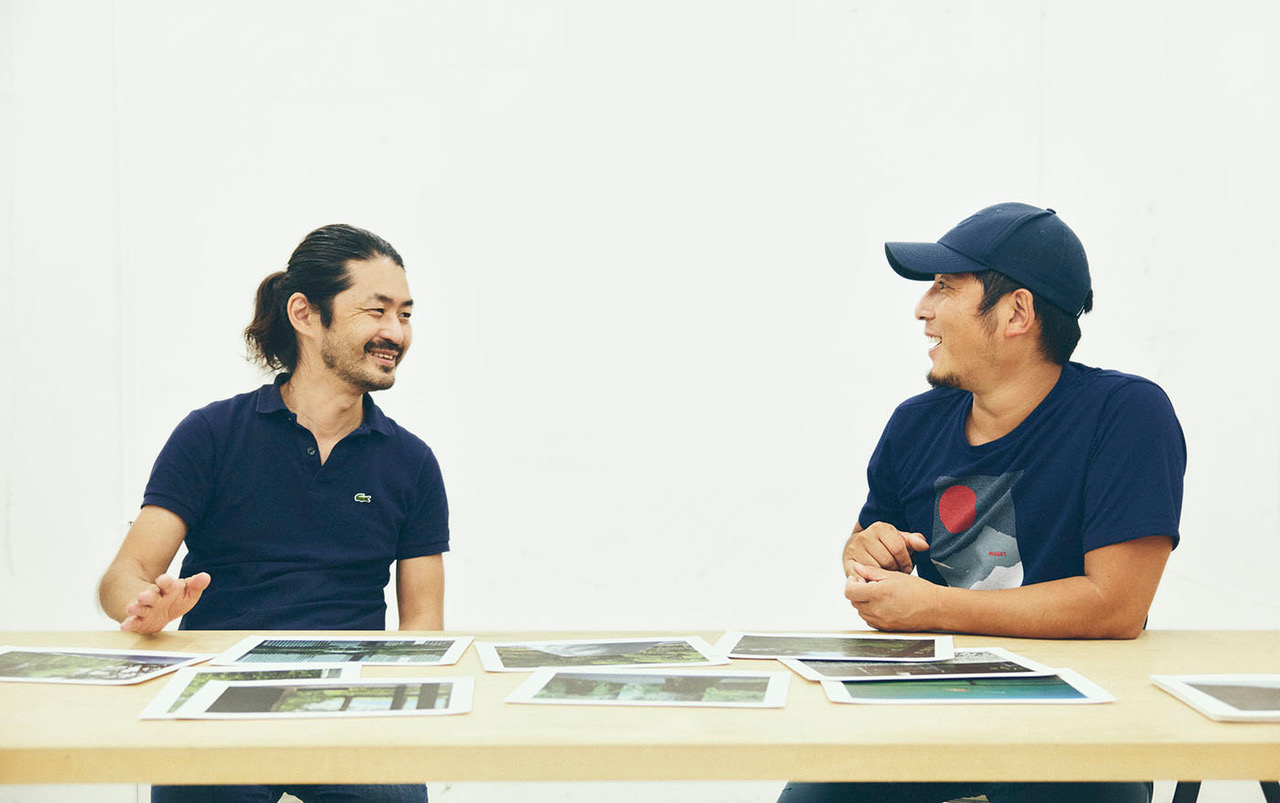
Mr. Yamaguchi, why did you decide to work with a photographer for your theme of shakkei, or “borrowed scenery”?
Yamaguchi:
I’d originally planned to take the pictures myself, but it took me a year just trying to decide on a
camera.
That sounds like you.
I finally bought one and started taking pictures, but I soon found myself facing the obvious reality that a great camera doesn’t necessarily mean you’ll always get terrific results. I looked at the pictures I’d taken, and I saw I just wasn’t capturing the things I wanted to get. That’s when I went to Mr. Kentaro Kumon.
Kumon:
Why were you interested in taking pictures of Japanese gardens, rather than Japanese architecture?
Yamaguchi:
With buildings, the styles, the construction methods of each era… almost every aspect is studied and
defined by the academic world as part of documenting the history of Japanese architecture. Buildings
have specific shapes, so you would think that the shapes say everything about them. But there’s actually
a great deal of information that can be read or interpreted there too. So, people have studied them from
every imaginable angle, creating a vast and profound world of Japanese architectural history.
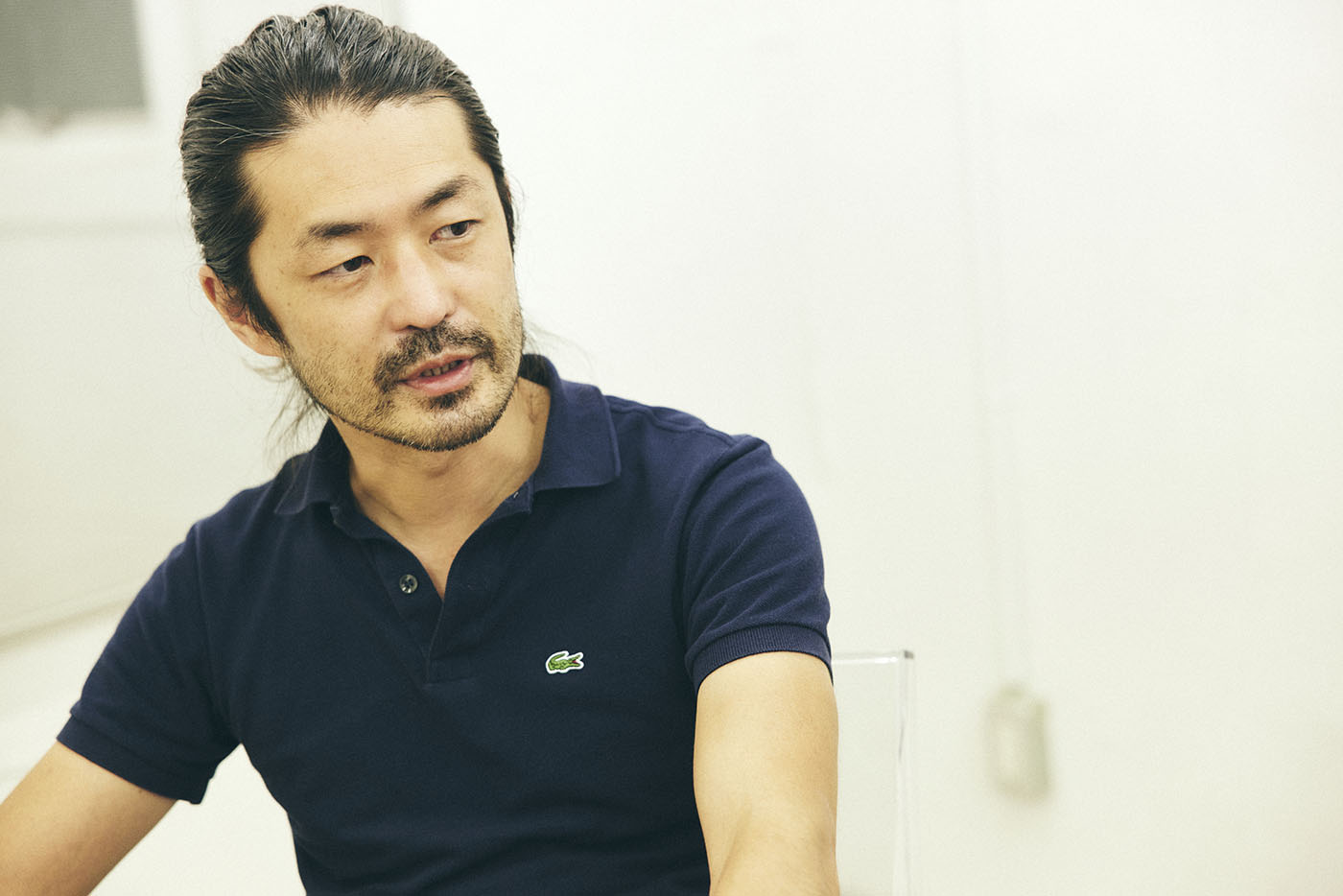
Of course, Japanese gardens have also been the subject of various studies too. But my interest in them is extremely subjective, which means it wouldn’t be viable as a proper field of research. Nevertheless, even if it doesn’t hold up as an academic paper, I feel there’s definitely something there. So, I thought that, rather than writing about it, perhaps I could communicate it through the medium of photography.
Mr. Kumon, what was your first impression after you heard from Mr. Yamaguchi?
Kumon:
He told me he was interested in the relationship between gardens and borrowed scenery, and that
initially he’d tried taking the pictures himself. And then the first place or actual site we visited was
Hama-rikyu Gardens.
Honestly, I was perplexed at first. As a photographer, sometimes people ask me to take pictures for them, and they explain to me what they’re after. So, here, I’d expected some sort of explanation like, “This garden is this sort of place, and people used to think of it like this. I see it like this, so I want you to take pictures like this.” But you were just like, “Isn’t this interesting?” So, it was hard trying to get a grasp of the kind of photographs you wanted.
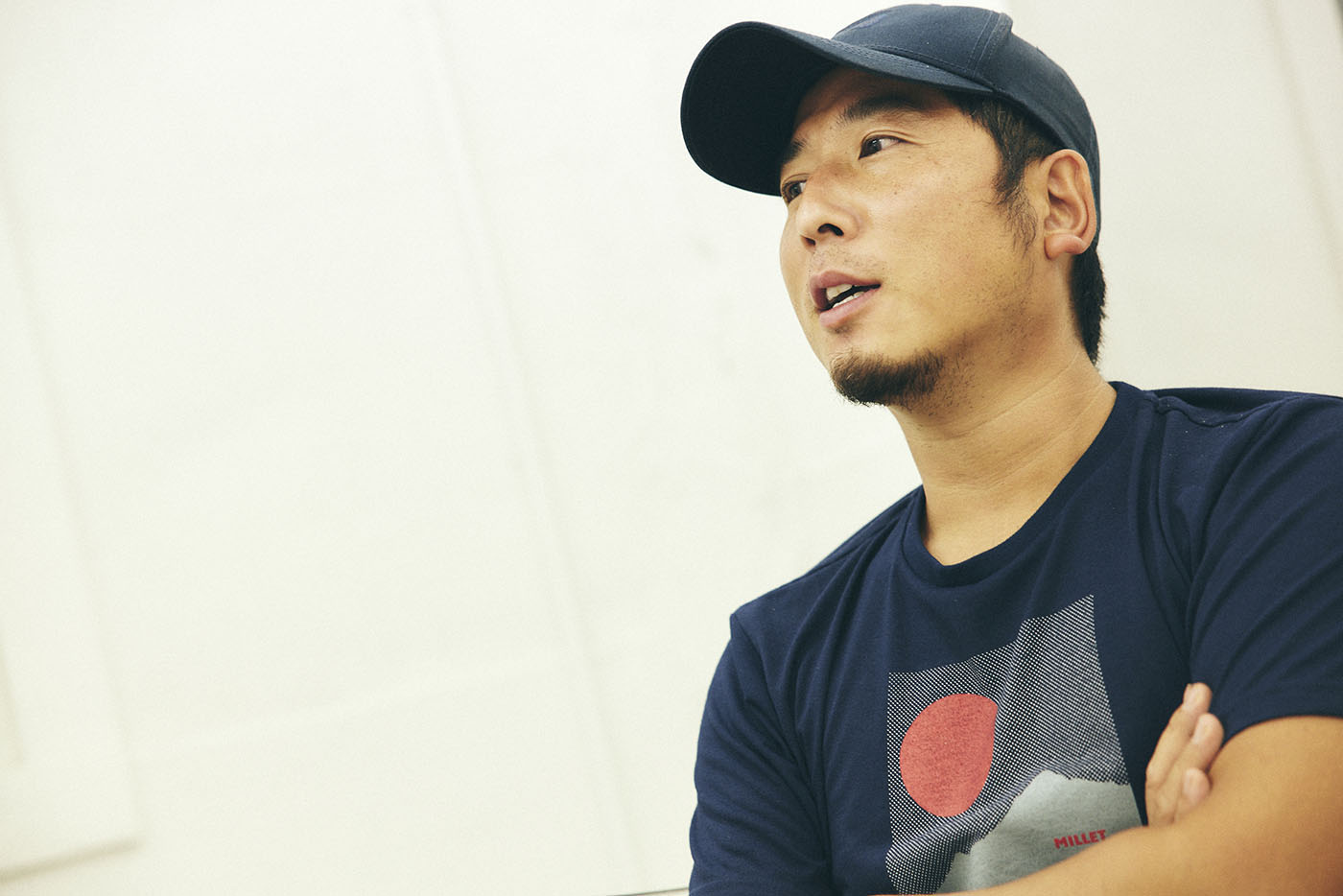
Yamaguchi:
I simply want to share the excitement of finding something cool. If you thought it was cool too, all the
better. Because I know I can’t capture that with my camera. The main reason I thought my shots were no
good was that they were trying to explain too much. I’d cram all these elements into my photos to try
and express my intent, and I’d end up with pictures that were too explanatory. I was mass-producing
photos that were like boring guidebooks.
I’d wanted to convey the essence of how a beautiful landscape can stop you in your tracks. But I couldn’t do that with my photos. I did try explaining the locations to you at first, but then I saw how excited you became once you started taking pictures. So, I left it all up to you.
Kumon:
The second place we went to was Koishikawa Korakuen Gardens, next to Tokyo Dome stadium. Although I
hadn’t been briefed very much, you’d told me you wanted to focus on the relationship between borrowed
scenery and Japanese gardens. So, I wanted to do something interesting within that framework.
I looked at the contrasts with the scenery beyond the pond or the garden and tried to interpret what was interesting in my own way, based on the theme of borrowed scenery. And I shot with a wide-angle lens, taking pictures which were, I guess, explanatory. And then, I’d finished walking all the way around the garden and came to a point where I couldn’t see the pond anymore, and took a picture there. It was like a snapshot I might take when I see something cool in the city. But the picture didn’t really tell you that the location was a Japanese garden. I guess you could say it included borrowed scenery, but it was actually just a snapshot.
Looking back, I think that’s the type of thing you wanted, and I eventually found myself going in that direction as well. So, the more we went to take photos together, the way I shot my pictures changed. Rather than incorporating explanatory elements into the frame, I began to simply look at the scenery in front of me and shoot what I felt was beautiful or interesting. I understood that explaining a concept with photos wasn’t what you wanted to do.
Yamaguchi:
I’ve actually been to Korakuen three times by myself to take pictures. But I’d try to get the pond, the
trees, and Tokyo Dome into the shot to express the idea of borrowed scenery. So, every time I went, I
only managed to get the same sort of pictures that tried to explain everything.
Even with your pictures when we went to Korakuen and Hama-rikyu, the pictures you took after I’d explained the specific locations and specific points of view… they had subjects and locations that were similar to mine. And that’s to be expected. So, then I stopped explaining. And after that, you snapped shots when you felt like it, and those pictures are more striking.
After two or three sessions like that, I would just take you to a location, give you the basics, and then just let you do your thing. To be honest, even if you’d asked me, “How about this area?” I wouldn’t know if it would work as a photograph. I don’t know what goes through a photographer’s mind when he sees a place, so I just trust your instinct and wait.
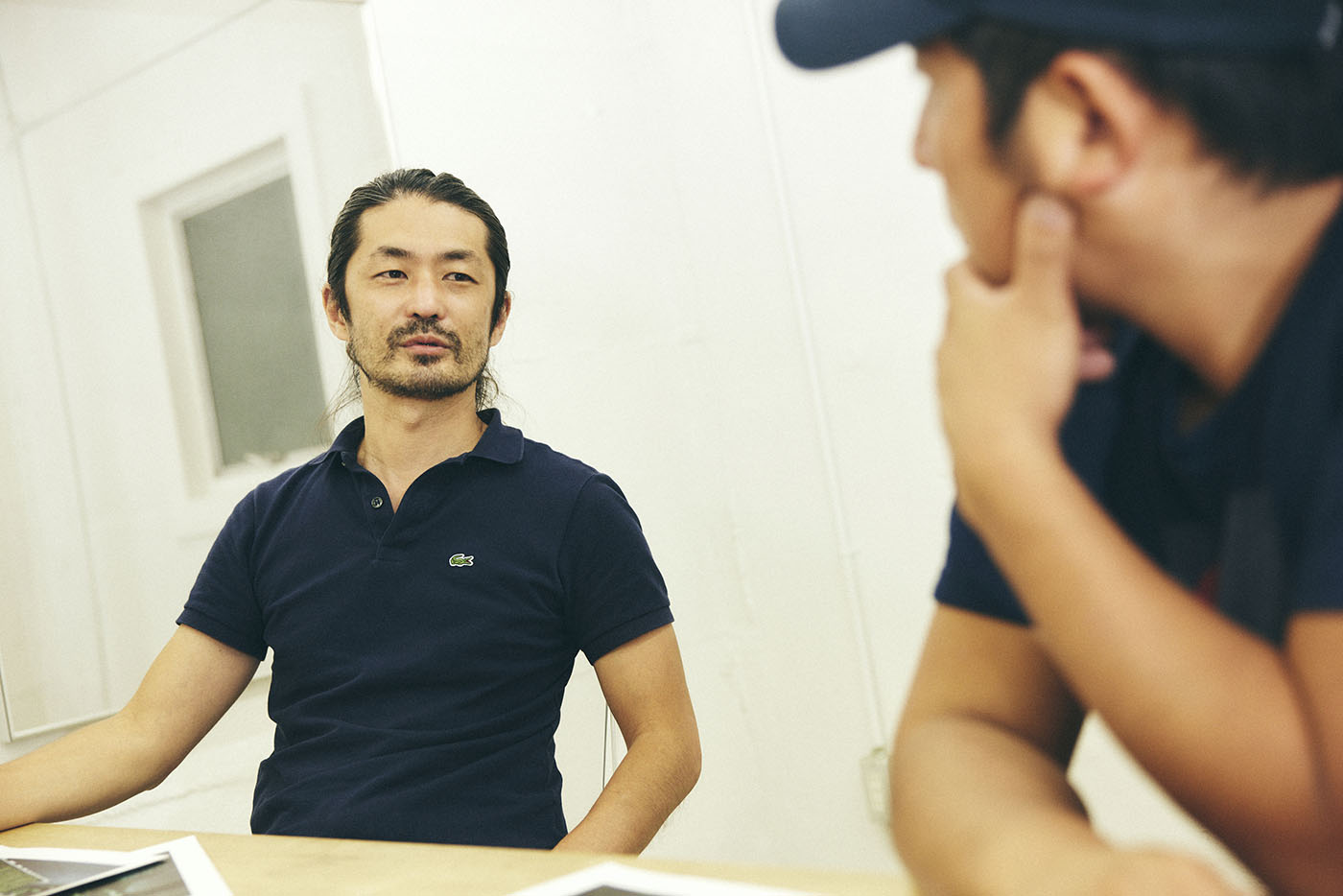
Kumon:
I’d actually been taking those pictures at Korakuen as extra shots with no intention of showing you.
Because I’d taken them for myself, after finishing the assignment.
At Hama-rikyu and Korakuen, my only focus for the project had been to try and find new types of borrowed scenery. But then we started going to Kyoto, which has an “orthodox” cityscape. And as I was trying to figure out what I should be shooting, the idea of “neighboring textures” really seemed to make sense in terms of where we were going with this project. Borrowed scenery is within the realm of neighboring textures, and so is myself reacting as a photographer.
I think it was around that time that I was able to really understand what you had in mind. From there, I started seeing more things, not just borrowed scenery. I began seeing “boundaries” too.
Yamaguchi:
I hadn’t connected the idea of borrowed scenery with neighboring textures at first either. I think it’s
often the case where people don’t like the presence of skyscrapers and other modern architecture around
a Japanese garden. But I believe that bringing them into view deliberately can also create new
landscapes. If modern architecture has become the new borrowed scenery, I thought it could be seen in a
fresh light as a new positive element of Japanese gardens. And that’s the kind of thing I wanted you to
capture.
The theme then gradually expanded from there on. It wasn’t only about buildings and gardens anymore. It spread to encompass the idea that, in terms of detail, adjoining materials are also neighboring textures. It’s the same with a new building standing behind a Japanese garden. Both can be borrowed scenery for each other, and they can be regarded as neighboring textures.
This “neighboring textures” was originally a phrase I’d used to explain my designs. Japanese gardens are made up of several different elements, not only borrowed scenery, and there are many combinations of many materials. And so, we finally reached the idea that they could be interpreted as “neighboring textures.”
Mr. Kumon, you work with film, which means you can’t check your shots immediately after you take them, unlike digital photography. How do you select the photos you show Mr. Yamaguchi?
Kumon:
When I was taking the pictures, I might’ve been pointing the camera in places he said were cool. But
what’s interesting about a location and what’s interesting about its photos are two different things.
So, I don’t select photos that can only turn out a certain way, no matter who takes them. Of course, I
could show him the pictures based on his direction. But as a photographer, I choose to show the pictures
that are interesting to me.
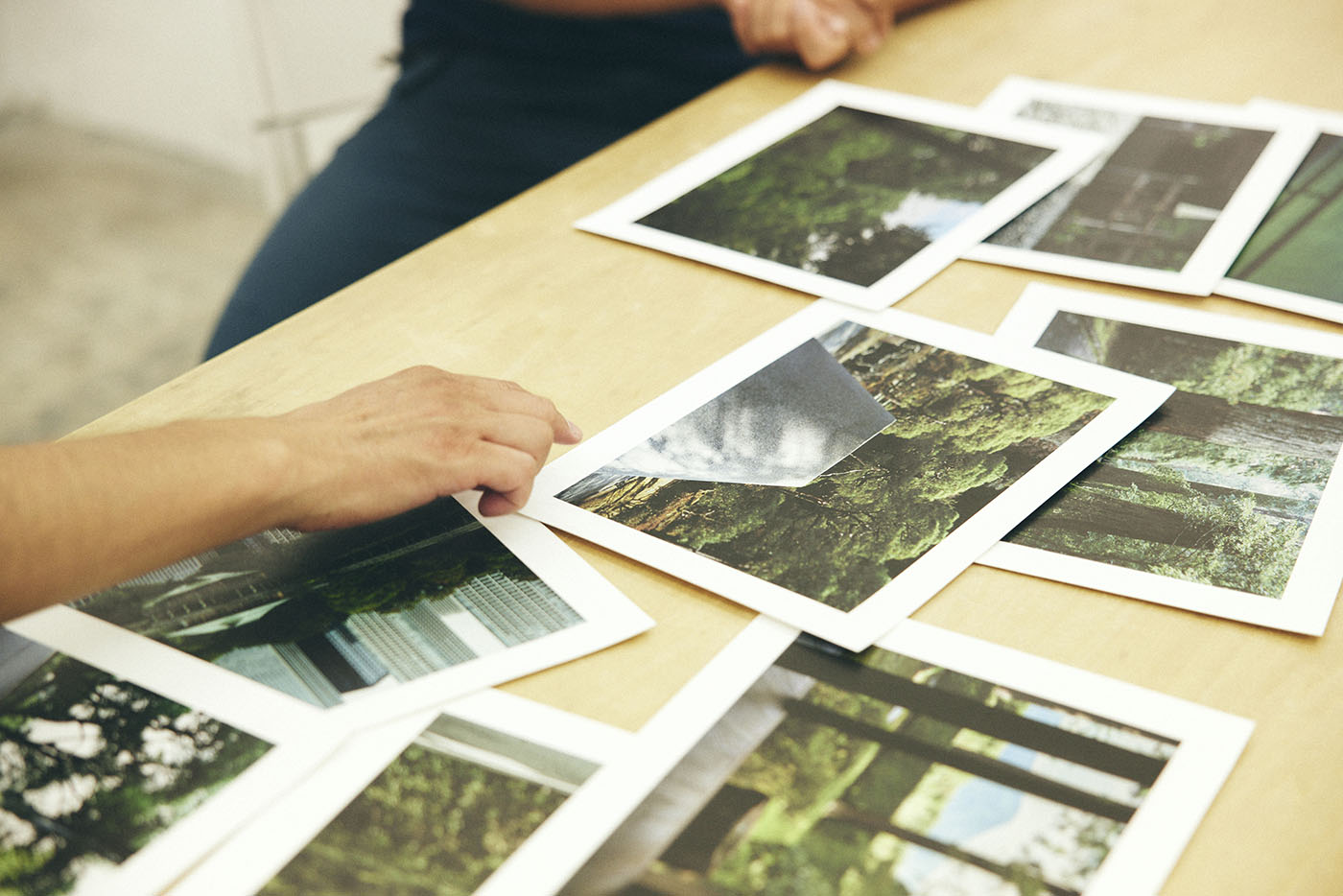
One of the first shoots we did was at Kogetsudai of Ginkakuji Temple. And I was using an 11-24 mm wide-angle lens, which is what you’re supposed to do if you’re taking pictures of a garden. But since our stay in Kyoto was short and our time was limited, I finally decided to settle for using a 35 mm lens. What I find interesting is things like the beauty of shapes and background, or the look of shadows created by streaming sunlight. And I snapped a bunch of photos really based on reflex or how I felt. Now I think the idea of neighboring textures has already become a part of my way of thinking too. So, I have a better idea of what you’d like to see. Sometimes, you’re the one who finds hidden meanings within my photos.
Yamaguchi:
When you go to Takihara-no-miya, which is an associated shrine of Ise Jingu Shrine, you’ll see there’s a
clear distinction between areas with white gravel and areas with black gravel, both small rock fragments
of similar size. This can be interpreted as the white area representing sacred ground and the black area
representing everything else that’s of this world. But this division is expressed simply by the
difference in the color of the gravel, whether it’s black or white. It’s only in Japan where you can
create and share this sense of a sacred area, by simply changing the color of the stones. You could say
this unique sense of boundary is also a characteristic of Japanese culture.
Another interesting way of creating a boundary can be seen with the hedgerow at Katsura Imperial Villa, which used to be one of the emperor’s retreats. The hedge is made of bamboo grass, and beyond it is the area where the emperor and nobles used to take walks. It might be easier to understand if you think of what other countries tend to do. Whether it’s in the West or in China, they would have high stone walls or multiple fences, or they would place sculptures to demarcate a special area, so that it’s apparent to everyone. These devices also act as physical barriers. Meanwhile, the hedge at Katsura Imperial Villa simply defines a division between the inside and outside. You could easily climb over it, or break it down.
And then, what’s special about the Katsura Imperial Villa hedge is that the bamboo, which normally grows straight up and tall, is bent downwards. It’s said that this bamboo hedge was also created to prevent the flooding and mud from the Katsura River, which flows nearby. But my focus isn’t on the functional aspect of the hedge, but the expression of the bamboo leaves from the bent and overlapping bamboo stalks, against the backdrop of ordinary bamboo trees just behind the hedge, growing ever upwards.
The people who created the hedge didn’t do anything to change the essence of nature or the material itself. It’s just how they’ve arranged the colors, how they’ve placed the materials, and how they’ve sectionalized the way they treat them. It’s still bamboo. It’s still nature. It’s just that there’s nature in its natural state next to nature that’s treated differently.
The same can be said with Japanese food. With sushi, you enjoy eating several types of just thinly sliced raw fish, one after the other. It’s literally the idea of neighboring textures. And sometimes you eat sushi with just a little salt. So, it’s about enjoying the subtle differences of the ingredients, but you also find it delicious because of the rich range of subtle differences. If you take a look around the world, most countries create menus that produce simple contrasts, so that when you have fish, the next dish is meat.
WIth tuna sushi, you have akami, chutoro, otoro... all of these are the same fish. But the Japanese people have found subtle differences between them, and enjoy tasting all of them and comparing them. In other words, they enjoy having them side by side. And so, in terms of the idea behind how we approach textures, I believe that neighboring textures doesn’t only apply to Japanese gardens, but is a common factor in other parts of Japanese culture too.
Kumon:
That’s something I’m really interested in as well. I’ve been producing photographic work based on the
theme of scenery created by people and their everyday lives. Agricultural scenery is something that’s
been nurtured by making use of what’s there.
The soothing beauty of the farming landscape is something that has been shaped by the wisdom of the Japanese people. It’s not something that has been created with the intent of creating a beautiful landscape. I feel that those experiences and thoughts are alive in this idea of neighboring textures too. Everything is linked. Once I noticed that, it’s become more exciting for me.
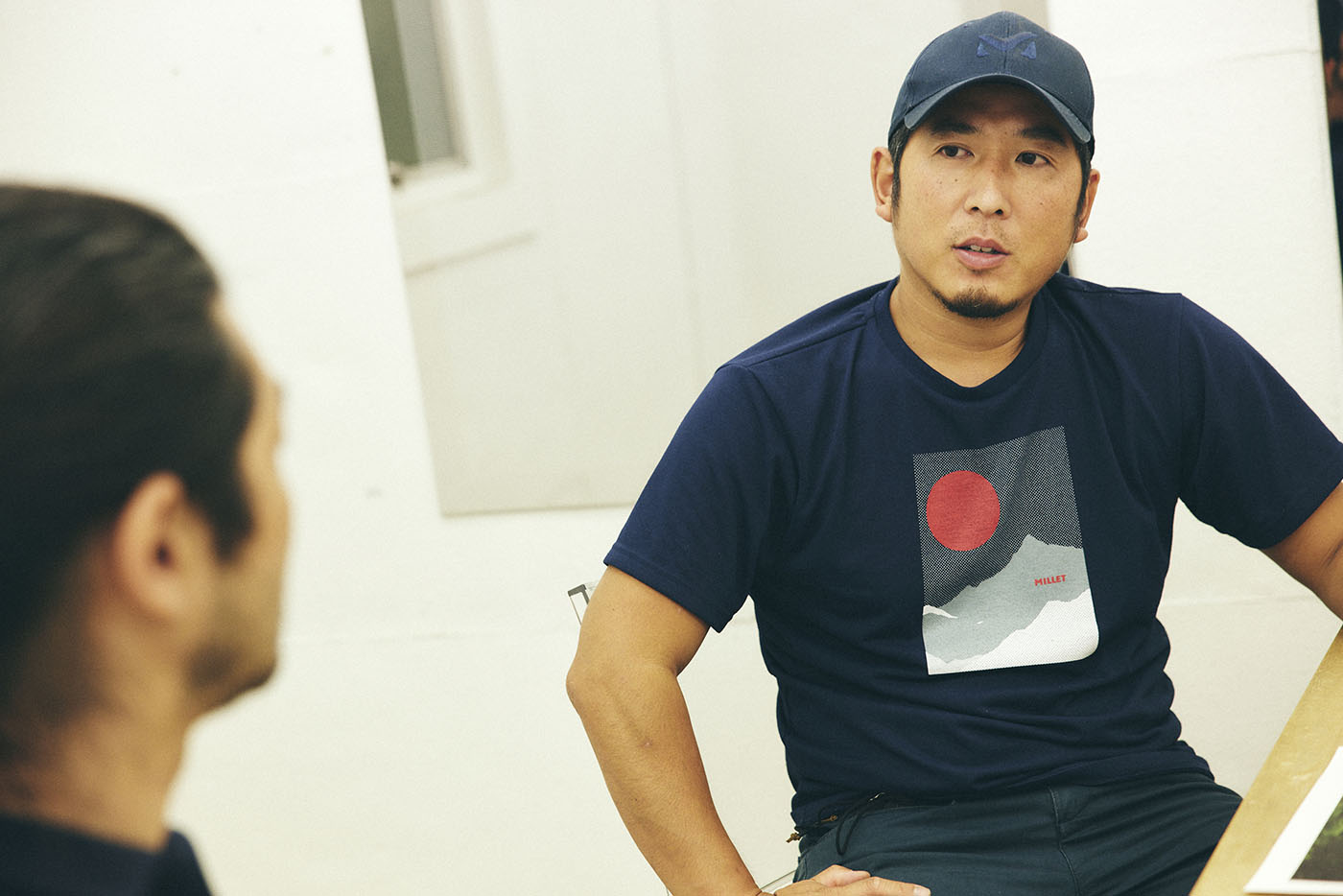
Mr. Kumon, when we look at your photos in chronological order, it seems they have changed over time. Why is that?
Kumon:
My grandfather is actually an architect. So, when I think of an architect, I think of my grandfather.
When I was little, my grandfather used to take me to temples and other places, and he would try to
explain them to me. And I only have memories of being really bored. But now, I think I’m beginning to
see how I should view them. I do find them simply interesting, and I don’t feel the need for commentary.
It’s been exciting. For my pictures, I used to pull back with a wide- angle lens to get shots that were
explanatory, but I’ve gradually been closing in. I think I can do that now because I’ve started to see
the hidden aspects in a subject. The fact that the idea of “neighboring textures” made sense also
helped.
Mr. Yamaguchi, is there anything you’ve discovered through Mr. Kumon’s photographs?
Yamaguchi:
When I first shared my thoughts on the theme of borrowed scenery with him, I expected it would cover a
wide range, but then it connected with more things than I’d imagined. I didn’t think we would be going
into the context of neighboring textures. That was a new discovery. But it wasn’t like “I’ve discovered
new territory.” It was more like my fuzzy image of an idea became more visually defined through his
photographs.
It also became clear to me that I was interested in seeing slightly different things being next to each other, whether it’s textures, scenes, or functions. I find it interesting seeing Japanese gardens from the perspective of neighboring textures. Or it might be that, if I went to a garden and couldn’t find any neighboring textures, it wouldn’t be very attractive to me.
So, Mr. Kumon’s photographs helped clarify Mr. Yamaguchi’s thoughts and helped him make new discoveries. How about you, Mr. Kumon?
Kumon:
Just as looking at gardens made him realize that the identity of his Japanese architecture has been
nurtured by Japanese culture, I’ve begun to think about my work like that too.
If you think of everyday life in Japan – having flower arrangements, taking your shoes off and placing them properly, or having a stepping-stone where you can remove your shoes in the garden – these are things based on an aesthetic sense that has been built up throughout Japanese history. When you have an awareness that our senses have been developed in such a way, I think it changes how we view everyday life. At the moment, I’m getting interested in Japanese crafts and tools, because with this perspective maybe I might be able to discover something new.
Interview and text by Mai Tsumuraya